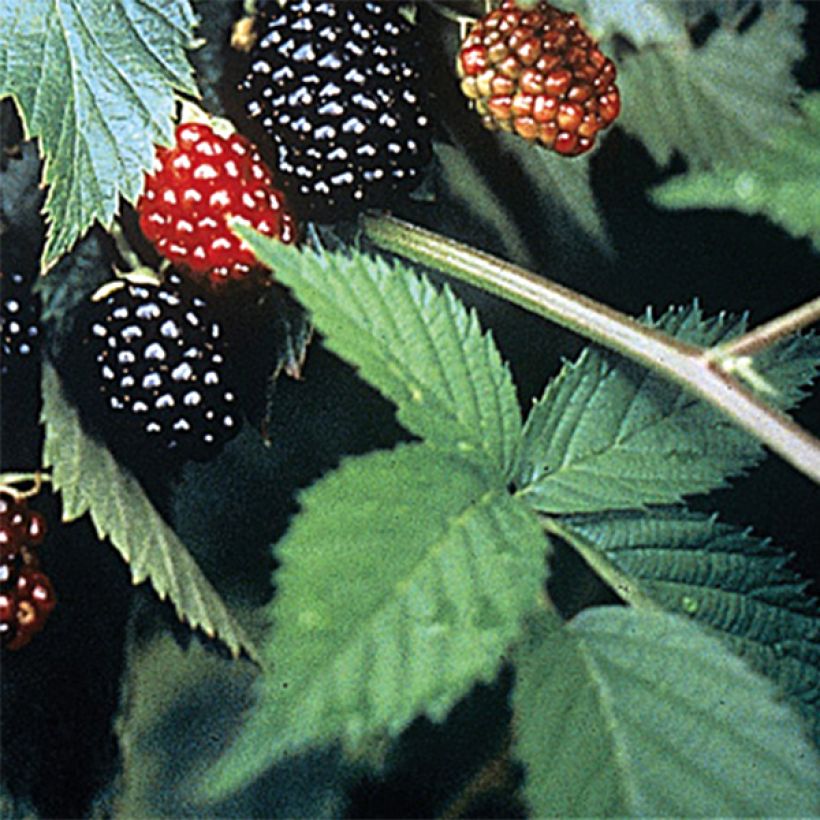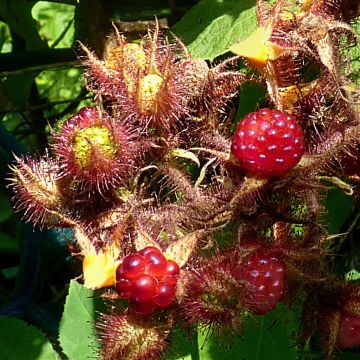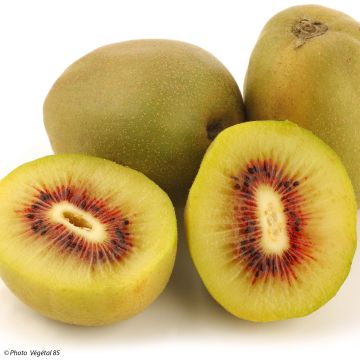

Thornless Blackberry Loch Ness - Rubus fruticosus
Thornless Blackberry Loch Ness - Rubus fruticosus
Rubus fruticosus Loch Ness
Blackberry, Bramble
This item cannot be shipped to the selected country
Delivery charge from €5.90
Delivery to Corse prohibited
More information
Schedule delivery date,
and select date in basket
This plant carries a 6 months recovery warranty
More information
We guarantee the quality of our plants for a full growing cycle, and will replace at our expense any plant that fails to recover under normal climatic and planting conditions.
From €5.90 for pickup delivery and €6.90 for home delivery
Express home delivery from €8.90.
Delivery to Corse prohibited: UE law prohibits the import of this plant from mainland France to Corse as part of the fight against Xylella fastidiosa. Please accept our sincere apologies.
More information


Description
The Loch Ness Blackberry is a thornless variety of garden blackberry. Its large elongated fruits weigh up to 4g. They are shiny black with violet reflections. Firm and slightly acidic, they are juicy and deliciously fragrant. They are ideal for eating fresh or in pies. The harvest takes place once the fruits are ripe, from late August to October.
The Blackberry belongs to the Rubus genus, which originates from the mountains of the Caucasus in Asia Minor. The genus has diversified over time and has given rise to several subgenera, including raspberry (Rubus idaeus) and common blackberry (Rubus fruticosus). This latter genus has numerous subspecies with differences in fruit size, colour, and acidity. In Europe and America, this berry has been consumed for about 2000 years. The Loch Ness Blackberry, of European origin, belongs to the Rubus fruticosus subgenus and is part of cultivated blackberries.
Hardy and easy to grow, the Loch Ness Blackberry is content with ordinary soil, although it prefers fertile, well-drained, and fresh soil. It will thrive against a sunny or partially shaded wall, showcasing the bare wood of its flexible branches in winter. Garden blackberries are hybrids derived from the thornless common blackberry, Rubus var. inermis, itself obtained through cross-breeding between the blackberry and the raspberry. Extensive work on improvement and selection has led to the development of numerous thornless varieties, many of which are of American origin.
The Loch Ness Blackberry is a climbing perennial plant with a semi-shrub and bushy habit. The branches can reach a length of 2 to 3 m (7 to 10ft), and the stump can occupy 0.5 m (2ft) of the ground. These branches will need to be trained: fence, wire mesh, trellis, pergola, arches, there are many solutions.
The foliage is deciduous, bright green, composed of compound and dentate leaves with visible veins, very similar to raspberry leaves. The stems are thornless. They only live for fruiting (2 years) and are gradually replaced by suckers emerging from the stump.
The abundant and honey-scented flowering consists of numerous small white-pink flowers, 1.5 to 2 cm (1in) in diameter, grouped in clusters. It takes place from May to June, starting from the first year of planting.
The formed fruits are composed of aggregated drupes attached to the receptacle. They are large in size, much larger than those of wild blackberries, turning from red to black when ripe, from August to November. They should be picked when fully black, as they are then sweet and tangy, juicy and flavorful. The fruits can be consumed fresh after picking, in jellies, jams, on pies, or even in sorbets, syrups, and juices. They can be perfectly preserved in the freezer.
Report an error about the product description
Thornless Blackberry Loch Ness - Rubus fruticosus in pictures




Plant habit
Fruit
Flowering
Foliage
Botanical data
Rubus
fruticosus
Loch Ness
Rosaceae
Blackberry, Bramble
Cultivar or hybrid
Other Blackberry bush
Planting and care
The Loch Ness Blackberry Bush prefers deep, fertile soils that are not too dry but rather moist, although it is a low-maintenance plant that will adapt to any ordinary soil that is not too dry. This blackberry bush bears fruit in the sun, in partial shade, or even in shade, although the fruits will be of lesser quality. When grown in a pot, it can be planted at any time of the year. However, it is preferable to plant it in the garden in autumn, from September to December.
Dig a hole twice as large as the root ball. Loosen the root ball with a lightly sharp tool to loosen the root mass and promote growth. Place the bush in the hole without burying it too deep. Water well to compact the soil and eliminate air pockets around the roots. It is important to ensure that the plant does not lack water during the first year after planting. Similarly, during the first year, only keep the vigorous stems. Adding organic fertilizer at the start of the growing season is beneficial. Train the new stems as they grow to prevent overgrowth: the blackberry bush naturally layers, meaning that if a branch touches the ground for an extended period, it will develop roots and new shoots, creating a new bush.
Planting period
Intended location
Care
-
, onOrder confirmed
Reply from on Promesse de fleurs
Berries
Haven't found what you were looking for?
Hardiness is the lowest winter temperature a plant can endure without suffering serious damage or even dying. However, hardiness is affected by location (a sheltered area, such as a patio), protection (winter cover) and soil type (hardiness is improved by well-drained soil).

Photo Sharing Terms & Conditions
In order to encourage gardeners to interact and share their experiences, Promesse de fleurs offers various media enabling content to be uploaded onto its Site - in particular via the ‘Photo sharing’ module.
The User agrees to refrain from:
- Posting any content that is illegal, prejudicial, insulting, racist, inciteful to hatred, revisionist, contrary to public decency, that infringes on privacy or on the privacy rights of third parties, in particular the publicity rights of persons and goods, intellectual property rights, or the right to privacy.
- Submitting content on behalf of a third party;
- Impersonate the identity of a third party and/or publish any personal information about a third party;
In general, the User undertakes to refrain from any unethical behaviour.
All Content (in particular text, comments, files, images, photos, videos, creative works, etc.), which may be subject to property or intellectual property rights, image or other private rights, shall remain the property of the User, subject to the limited rights granted by the terms of the licence granted by Promesse de fleurs as stated below. Users are at liberty to publish or not to publish such Content on the Site, notably via the ‘Photo Sharing’ facility, and accept that this Content shall be made public and freely accessible, notably on the Internet.
Users further acknowledge, undertake to have ,and guarantee that they hold all necessary rights and permissions to publish such material on the Site, in particular with regard to the legislation in force pertaining to any privacy, property, intellectual property, image, or contractual rights, or rights of any other nature. By publishing such Content on the Site, Users acknowledge accepting full liability as publishers of the Content within the meaning of the law, and grant Promesse de fleurs, free of charge, an inclusive, worldwide licence for the said Content for the entire duration of its publication, including all reproduction, representation, up/downloading, displaying, performing, transmission, and storage rights.
Users also grant permission for their name to be linked to the Content and accept that this link may not always be made available.
By engaging in posting material, Users consent to their Content becoming automatically accessible on the Internet, in particular on other sites and/or blogs and/or web pages of the Promesse de fleurs site, including in particular social pages and the Promesse de fleurs catalogue.
Users may secure the removal of entrusted content free of charge by issuing a simple request via our contact form.
The flowering period indicated on our website applies to countries and regions located in USDA zone 8 (France, the United Kingdom, Ireland, the Netherlands, etc.)
It will vary according to where you live:
- In zones 9 to 10 (Italy, Spain, Greece, etc.), flowering will occur about 2 to 4 weeks earlier.
- In zones 6 to 7 (Germany, Poland, Slovenia, and lower mountainous regions), flowering will be delayed by 2 to 3 weeks.
- In zone 5 (Central Europe, Scandinavia), blooming will be delayed by 3 to 5 weeks.
In temperate climates, pruning of spring-flowering shrubs (forsythia, spireas, etc.) should be done just after flowering.
Pruning of summer-flowering shrubs (Indian Lilac, Perovskia, etc.) can be done in winter or spring.
In cold regions as well as with frost-sensitive plants, avoid pruning too early when severe frosts may still occur.
The planting period indicated on our website applies to countries and regions located in USDA zone 8 (France, United Kingdom, Ireland, Netherlands).
It will vary according to where you live:
- In Mediterranean zones (Marseille, Madrid, Milan, etc.), autumn and winter are the best planting periods.
- In continental zones (Strasbourg, Munich, Vienna, etc.), delay planting by 2 to 3 weeks in spring and bring it forward by 2 to 4 weeks in autumn.
- In mountainous regions (the Alps, Pyrenees, Carpathians, etc.), it is best to plant in late spring (May-June) or late summer (August-September).
The harvesting period indicated on our website applies to countries and regions in USDA zone 8 (France, England, Ireland, the Netherlands).
In colder areas (Scandinavia, Poland, Austria...) fruit and vegetable harvests are likely to be delayed by 3-4 weeks.
In warmer areas (Italy, Spain, Greece, etc.), harvesting will probably take place earlier, depending on weather conditions.
The sowing periods indicated on our website apply to countries and regions within USDA Zone 8 (France, UK, Ireland, Netherlands).
In colder areas (Scandinavia, Poland, Austria...), delay any outdoor sowing by 3-4 weeks, or sow under glass.
In warmer climes (Italy, Spain, Greece, etc.), bring outdoor sowing forward by a few weeks.





















































